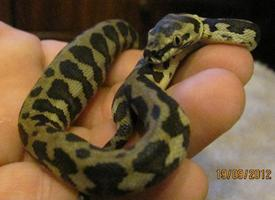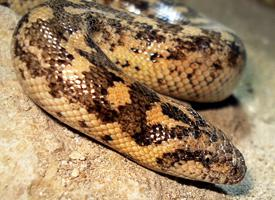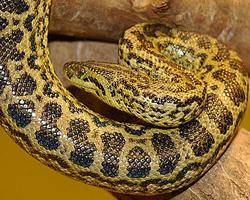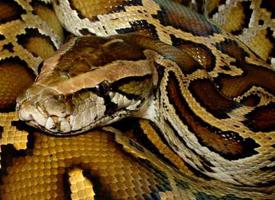
Biological data
| Length of gestation | from 3 to 4 m |
|---|
Animal description
The Carpet Python (Morelia spilota), a captivating species of python, is native to a wide range of habitats across Australia, including but not limited to rainforests, savannas, and shrublands. This species is highly adaptable and can also be found in New Guinea and Indonesia. Renowned for their distinctive and intricate patterns that resemble an ornate carpet, these snakes exhibit a remarkable diversity in coloration and pattern, which can vary significantly across their range. This variability has led to the identification of several subspecies, each adapted to their unique environmental niches.Carpet Pythons are medium to large snakes, with adults commonly reaching lengths of 2 to 4 meters, though some individuals have been recorded at lengths of up to 5 meters. Their body is robust and muscular, enabling them to adeptly climb trees and navigate through a variety of terrains. The color palette of their scales includes a mix of olive, gold, black, and grey, with their belly usually being a lighter color. The intricate patterns on their skin serve as excellent camouflage, allowing them to blend seamlessly into their surroundings and evade predators as well as ambush prey.
As carnivores, Carpet Pythons have a diverse diet that includes small mammals, birds, and sometimes reptiles. They are non-venomous constrictors, employing the method of coiling around their prey and suffocating it before consumption. This method allows them to tackle prey of various sizes. They are primarily nocturnal hunters, relying on their heat-sensing pits located around the mouth to detect warm-blooded prey in the darkness.
Reproduction in Carpet Pythons is oviparous, meaning the females lay eggs. The breeding season typically occurs in spring, with females laying a clutch of 10 to 50 eggs, depending on the size and health of the individual. Remarkably, female Carpet Pythons exhibit maternal care, a rare behavior among snakes, by coiling around the eggs to incubate them. They will often go without food during this period to maintain a constant temperature for the eggs, which usually hatch after two to three months.
Carpet Pythons play a significant role in their ecosystems as both predators and prey. They help control the populations of their prey species, and in turn, juvenile pythons often fall victim to birds of prey, larger mammals, and even other snakes. Despite facing threats from habitat loss, road mortality, and illegal pet trade, Carpet Pythons are listed as a species of Least Concern by the International Union for Conservation of Nature (IUCN), indicating that they currently face no immediate threat of extinction.
In conclusion, the Carpet Python (Morelia spilota) is a fascinating and complex species, characterized by its stunning appearance, ecological adaptability, and intriguing behaviors. As an integral part of the ecosystems they inhabit, understanding and conserving these magnificent snakes is crucial for maintaining biodiversity and ecological balance.
Similar Animals
New photos of animals
Top 10 animals
- Dolphin gull (Leucophaeus scoresbii)
- Japanese macaque (Macaca fuscata)
- Stone loach (Barbatula barbatula)
- Diana monkey (Cercopithecus diana)
- Galápagos tortoise (Geochelone nigra complex)
- Russian tortoise (Testudo horsfieldii)
- Moustached guenon (Cercopithecus cephus)
- Greek tortoise (Testudo graeca)
- Common house mosquito (Culex pipiens)
- Giant peacock moth (Saturnia pyri)


